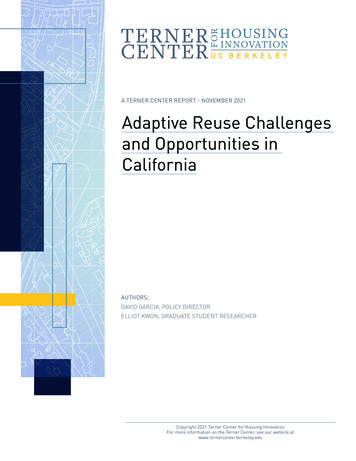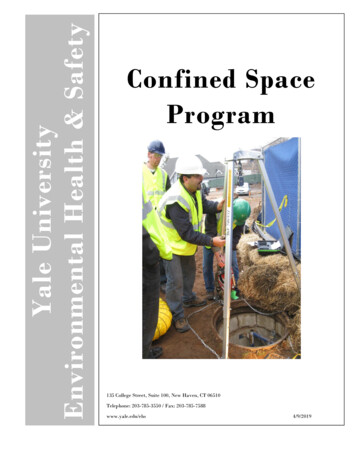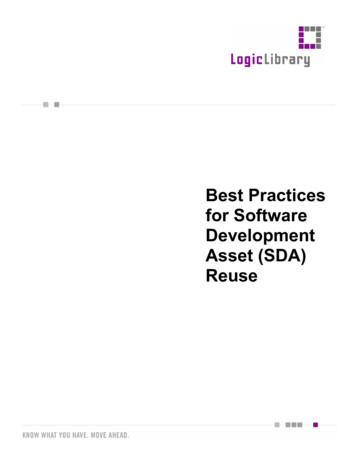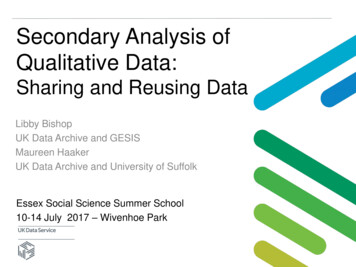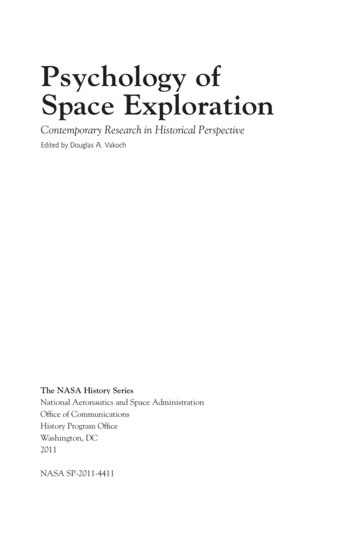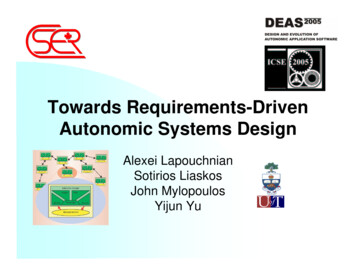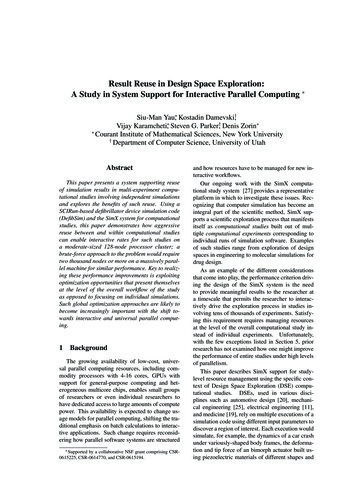
Transcription
Result Reuse in Design Space Exploration:A Study in System Support for Interactive Parallel Computing Siu-Man Yau , Kostadin Damevski†,Vijay Karamcheti , Steven G. Parker†, Denis Zorin Courant Institute of Mathematical Sciences, New York University†Department of Computer Science, University of UtahAbstractThis paper presents a system supporting reuseof simulation results in multi-experiment computational studies involving independent simulationsand explores the benefits of such reuse. Using aSCIRun-based defibrillator device simulation code(DefibSim) and the SimX system for computationalstudies, this paper demonstrates how aggressivereuse between and within computational studiescan enable interactive rates for such studies ona moderate-sized 128-node processor cluster; abrute-force approach to the problem would requiretwo thousand nodes or more on a massively parallel machine for similar performance. Key to realizing these performance improvements is exploitingoptimization opportunities that present themselvesat the level of the overall workflow of the studyas opposed to focusing on individual simulations.Such global optimization approaches are likely tobecome increasingly important with the shift towards interactive and universal parallel computing.1BackgroundThe growing availability of low-cost, universal parallel computing resources, including commodity processors with 4-16 cores, GPUs withsupport for general-purpose computing and heterogeneous multicore chips, enables small groupsof researchers or even individual researchers tohave dedicated access to large amounts of computepower. This availability is expected to change usage models for parallel computing, shifting the traditional emphasis on batch calculations to interactive applications. Such change requires reconsidering how parallel software systems are structured Supported by a collaborative NSF grant comprising CSR0615225, CSR-0614770, and CSR-0615194.and how resources have to be managed for new interactive workflows.Our ongoing work with the SimX computational study system [27] provides a representativeplatform in which to investigate these issues. Recognizing that computer simulation has become anintegral part of the scientific method, SimX supports a scientific exploration process that manifestsitself as computational studies built out of multiple computational experiments corresponding toindividual runs of simulation software. Examplesof such studies range from exploration of designspaces in engineering to molecular simulations fordrug design.As an example of the different considerationsthat come into play, the performance criterion driving the design of the SimX system is the needto provide meaningful results to the researcher ata timescale that permits the researcher to interactively drive the exploration process in studies involving tens of thousands of experiments. Satisfying this requirement requires managing resourcesat the level of the overall computational study instead of individual experiments. Unfortunately,with the few exceptions listed in Section 5, priorresearch has not examined how one might improvethe performance of entire studies under high levelsof parallelism.This paper describes SimX support for studylevel resource management using the specific context of Design Space Exploration (DSE) computational studies. DSEs, used in various disciplines such as automotive design [20], mechanical engineering [25], electrical engineering [11],and medicine [19], rely on multiple executions of asimulation code using different input parameters todiscover a region of interest. Each execution wouldsimulate, for example, the dynamics of a car crashunder variously-shaped body frames, the deformation and tip force of an bimorph actuator built using piezoelectric materials of different shapes and
material properties, the performance of a microprocessor under different designs, or the currentdelivered to the heart by variously-configured defibrillators. The objective of the study is to identifythe ’best’ of these simulations, as identified by restrictions on the ranges of input parameters and/oroutput performance metrics. The interactivity requirements come about because the researcher usually starts off with only a fuzzy set of requirements,which get refined as the study unfolds.The common theme underlying SimX supportfor DSE studies is the aggressive reuse of information provided by previous simulations to guidethe current action of the system. SimX exploitsreusable information across the entire spectrum ofits response to a researcher’s changing definitionof the study parameters — from deciding how bestto explore a portion of the design space all theway down to the execution of a single simulation.This information helps in a number of differentways, from guiding the search to allow explorationof design spaces whose size is otherwise too highfor the computational resources assigned to handlethe problem, to reusing internal simulation state tojump start the execution of a new simulation. Aninteresting aspect of SimX’s reuse support is thefact that it trades off parallelism for speed: nominally, the simulations making up a DSE are independent of each other; yet, introducing dependencies amongst them improves the overall performance of the study.We present the realization of these mechanismsin a SCIRun-based implementation of the SimXsystem [28], and demonstrate how, by exploitingre-use, one can achieve response times on the order of tens of seconds under various scenarios inan interactive defibrillator computational study using only a 128-processor cluster (with leftover capacity); a brute-force approach would require twothousand nodes or more on a massively parallelmachine for similar performance.The remainder of this paper is organized as follows. Section 2 describes how design space exploration is supported by our system and presents thedefibrillator design application [19], which willserve as a running example throughout the paper. Ataxonomy of different types of reuse and their implementation are presented in Section 3. In Section4, we evaluate the effectiveness of various types ofreuse using the defibrillator design study runningon the SimX system. Finally, we discuss relatedwork and conclude in Sections 5 and 6.2Design Space Exploration withSimX/SCIRunThe design space exploration platform described in this paper combines the SimX SystemSoftware for Interactive Multi-ExperimentComputational Studies [27], with the SCIRunproblem-solving environment [18].SimX isrealized as a set of SCIRun components, whichaugments the standard set and together supportsdesign space exploration computational studies, discussed in additional detail below. TheSimX/SCIRun system is designed to enableinteractive computational studies on small- andmedium-sized (32 to 128 nodes) clusters.Defibrillator design. We use a defibrillator design computational study as our primary test example. This study is a typical design space exploration (DSE) problem common in several engineering applications. An individual computational experiment [19, 13] models the application of defibrillator stimuli and resulting propagation of electriccurrent across a human torso.The goal of the study is to find positions of twodefibrillator electrodes on the surface of the torsoand a voltage difference between electrodes, whichtogether form a five-dimensional design space thatbalances several conflicting performance metrics:1. minimize percentage of heart tissue that experiences current flow above a damage threshold;2. maximize the percentage of heart tissue forwhich the electric current is above the activation threshold needed for defibrillation; and3. maximize the uniformity of the potential gradient in the heart tissues, defined as the ratioof the maximum gradient found in the heart tothe average gradient in the heart.We refer to the three-dimensional spacespanned by these performance metrics as the performance space. Performance metrics can be parameterized to represent slightly different problems. E.g., in order to model defibrillation for a patient with fat tissues surrounding a heart, the activation and damage thresholds can be set to a higherlevel, making it more difficult to activate and damage the heart tissues.The simulation code receives as its input theelectrode positions and voltages, and solves a 3DPoisson equation solved to obtain the potential distribution in the body; the potential gradient is usedto obtain the electric current. Then the performance evaluation code takes the result of the simulation code, and uses the performance metric pa-
rameters to find the performance metrics for thatexperiment.Typically, multi-objective optimization problems of this type [15, 25] aim to identify the setof input parameters resulting in Pareto-optimal designs (Pareto frontier) i.e. those for which improving one performance metric can only be achieved atthe expense of another, e.g., a defibrillator configuration is Pareto-optimal if activation cannot be improved while holding uniformity and damage levelfixed, and vice-versa. The user applies additional,often imprecisely defined, criteria to pick a finaldesign on or close to the Pareto frontier. One criterion the user may use can be the admissible region- a sub-region in the performance space where anydesigns that achieve performance metric that fallinto that space are disregarded, e.g., defibrillatorsettings that activate less than 5% of the heart, nomatter how well they perform in other performancemetric, are automatically discarded.Interactive design space exploration.TheSimX/SCIRun system provides an interactive environment for exploring the design space and identifying relevant Pareto-optimal configurations.In our model of interactive design space exploration, the user, using the partial results presentedby the system, interactively adjusts how the problem is specified (see Figure 2 for an example workflow). Specifically, the user can adjust the following parameters: (1) performance metric parameters (e.g., activation threshold and damage threshold); (2) admissible regions for performance metric (e.g., minimal acceptable percentage of tissueactivated); (3) region of exploration in the designspace (e.g., a 2D subset of the design space wherethe position of one of the electrodes and the shockvoltage are fixed, and the area on the torso wherethe other electrode can be placed is bounded).We regard each change of parameters by theuser as a new study, i.e., each study is defined bya region in design space, a set of performance metric parameters, and a region in performance space(the admissible region). For each study, the system computes and visualizes the Pareto frontier,reusing the computation from previous studies tothe maximal extent possible.SimX/SciRun system overview. The overallstructure of the SimX/SCIRun system (Figure 2)at the process level includes a manager process,multiple worker processes and a fixed number ofSpatially-Indexed Shared Object Layer (SISOL)servers, which provide a shared state repositoryused by the system. The manager and worker processes are assembled from components providedby SCIRun and SimX. SISOL servers are entirelyapplication independent.To build an application within theSimX/SCIRun framework, the user needs todesign a visualization/user interaction module,hosted in the manager, a simulation module, hostedin the workers, and optionally a sampler module,also hosted in the manager. The sampler module isresponsible for deciding, based on the current setof results, which design-space point will be evaluated next. Unlike visualization and simulationmodules, this module is less application-specificand the same module can be used for a broad rangeof problems. SimX currently provides two samplermodules: a simple parameter sweep sampler andan adaptive sampler, described in additional detailin Section 3.2.The SCIRun problem solving environment provides a variety of high-level components facilitating implementation of simulation and visualization/user interaction (UI) modules, the latter atboth the level of individual simulations as well asthe entire design space exploration (Some examples of the UI elements for the defibrillator designexample can be seen in Figure 2.) SimX plugs innaturally into the SCIRun architecture by exposingits interfaces in the form of SCIRun modules thatcan be directly hooked up as required with the simulation and UI modules.During design space exploration, once the userspecifies a study parameter, the SimX manager obtains from the sampler a set of design space pointsto explore and distributes them to workers alongwith information on performance metric parameter settings. Worker processes execute the simulations, optionally retrieving state about previouslyrun simulations from the SISOL servers to supportthe reuse optimizations described in Section 3, andsend the performance metrics evaluated back to themanager. Upon receiving the performance metrics, the manager registers the performance metrics with the sampler and obtains additional design space points to explore. The communicationbetween manager and worker processes is accomplished through asynchronous interfaces; a workercan overlap invocation of a new simulation withcommunication of the prior simulation’s results tothe manager.From an application programmer point ofview, SimX functionality is exposed via a setof sampler and SISOL interfaces. User-suppliedsamplers need to implement the sampler interface, so that it can be called by the manager, the most important functions of which aregetNextPointToRun, registerResults,and getEvaluated. The latter function retrieves design space points for which simulations
design space points,perfomance rmancemeasure valuessimulation resultsfor vizualizationmanagercomm.Figure 1. Interactive DSE: To begin, the user selects an area in front of the torso,sets the back electrode’s position, and sets the shock voltage (far left). As the initialPareto-optimal placements are discovered (center left, zoomed-in view), the user increases the activation threshold voltage, and the system responds by displaying thenew Pareto optimal points (center right). The user can also select an entirely differentarea to explore (far right).Workerdata for reuseSISOLserverSISOLserverSISOLserverperf. measureevaluationsimulationSISOL comm.simulation results,other reuse dataSISOLserverFigure 2. Overall SCIRun/SimX system structure; processes are shown in gray, SimXcomponents in orange, application-specific components in blue.were already performed with associated performance metrics.SISOL gets its name from the fact that objects are named and indexed using spatial coordinates, a natural fit to the design space and performance metric elements that typically get stored inthe layer. The SISOL interface, available to boththe application-independent manager and workermodules as well as the application-specific sampler and simulation modules, supports the operations Insert/Remove for inserting/removing anobject at a given location in the spatial database,QueryClosest for returning a list of object handles associated with nearby points in design space,and associated functions for retrieving and storingobject data. Table 1 shows the high-level SISOLAPI.These SISOL interfaces are currently implemented using a variable number of stand-alonedata servers and a directory server; the architecture can be additionally scaled by partitioning theobject namespace. The data servers store the actualobjects, all in volatile memory, while the directoryserver maintains information about which spatialcoordinate is stored on which data server. After anindividual study is completed results are not discarded to enable inter-study reuse of the kind described in Section 3.2.3Reuse OpportunitiesSpace ExplorationinDesignIn our initial experiments with the defibrillator design study, we quickly found that the default parameter-sweep sampler would yield studyresponse times that were far from interactive, oftenrequiring the user to wait tens of minutes or longerbefore receiving feedback that could drive refinement of the performance metrics. This led to an extended period of iterative experimentation, wherewe investigated several different approaches forbringing the study response times down to acceptable interactive rates (tens of seconds or lower).This section summarizes what we discovered to bethe most effective approaches, all of which sharethe same underlying key idea: that of maximallyreusing information contained in previous simulation runs to substantially improve the study performance moving forward.
S IGNATUREint CreateSet(int setID, int typeID,int arity, double *weights, int capacity)int RegisterSet(int setID, void** objSet)void UnregisterSet(void* objSet)void Insert(void* objSet, double* coords, void* obj)void Remove(void* objSet, double* coords)void* StartRead(void* objSet, double* coords)void* StartWrite(void* objSet, double* coords)void EndRead(void* objSet, double* coords, void* obj)void EndWrite(void* objSet, double* coords, void* obj)void QueryClosest(void* objSet, double* coords, intnumToLookup, int* numRetrieved, double** retrCoords)F UNCTIONCreate object set of arity dimensionsto store objects of type typeID. Theweights array specifies a weightedEuclidean distance metric.Registers client as participant; retrievesobject set metadata in objSet.Unregisters client.Insert/remove an object into/from theset.Start/end a read/write operation on anobject.Query for up to numToLookupclosest neighborsTable 1. Interface of the spatially-indexed shared object space layer (SISOL).In general, the reuse of previous results benefitsinteractive design space exploration in two ways:by reducing the number of simulations that have tobe performed for a given study and by reducing thework needed for a given simulation. We start bylisting the broad types of reuse opportunities thatwere found to be most beneficial, and then describethe SimX/SCIRun system support that was neededto derive this benefit.3.1Types of ReuseIntra-study reuse in the sampler module. Inthe course of a single study, simulation results canbe used to guide design space sampling strategies,often yielding the same overall results while exploring only a tiny fraction of the overall designspace. This observation manifests itself in the design of a smarter sampler module in SimX, the Active Sampler (an early version of which was described in [27]), which first performs a coarse parameter sweep over the region of design space to beexplored, and uses the performance metric of thosepoints to construct a coarse approximation of thePareto frontier. It then refines the grid to explorethe neighbors of those points, eliminating “unimportant” parts of the design space early in the study.Note that the Active Sampler artificially introduces dependencies amongst the simulations explored in the study, by not issuing design spacepoints corresponding to a finer resolution sweepuntil it receives results for the coarser sweep. Thisreduction in parallelism is justified by an overallbenefit in study response times.Inter-study reuse in the sampler module. If auser performs an action that causes the system toswitch from exploring one study to another study(e.g., changes a performance measure parametersuch as activation threshold), we can use the resultsfrom the first study to aid the second study. For example, the system can take the approximation ofthe Pareto frontier obtained in the first study to actas the initial Pareto frontier approximation for thesecond, reducing the total number of experimentsneeded. This reuse, beneficial in situations wherethe second study is a refinement of the first (as istypical for design space exploration), has the effectof replacing part or all of the coarse-grained Active Sampler exploration for the second study withresults from the first study.Inter-study result reuse in the manager module: performance metric reuse. Recall from Section 2 that the user inputs during design spaceexploration can consist either of changes in performance metric parameters, establishing new admissible performance space regions, or requesting exploration of a different design space region.In the latter two scenarios, it is possible that thesame simulation be re-issued with the same performance metric parameters for a different study.When that happens, the manager module can simply look up the performance metrics from the listof previously-completed experiments, and thus cutdown the number of simulations that need to be allocated to Worker processes.Inter-study result reuse in the simulation modules: simulation result reuse. If the user changesonly the performance metric parameters, it is possible that the same simulation be re-issued withdifferent performance metric parameters for a different study. In those cases the worker processcan lookup the simulation result from a list ofpreviously-completed simulations instead of running the simulation code, and re-compute only theperformance metrics. In the specific example of thedefibrillator study, this corresponds to reusing the
potential distribution values obtained as a solutionto the 3D Poisson equation.Intermediate result reuse in the simulationmodule. Even when different simulations are issued with different performance metric parameters,there are still reuse opportunities. This type ofreuse heavily depends on the internals of the simulator code, and although applicable to other numerical simulations, is the least generic. The defibrillation simulation used in our experiments involvessolving three linear systems, each correspondingto setting the boundary condition of the front electrode to the three surface mesh nodes nearest to it.Since many simulations set boundary conditions tothe same mesh nodes, we store the result of each invocation of the solver, and the simulation code canlooks up the solutions to skip solving those systemsthat had previously been solved.Preconditioner reuse in the simulation module.If the solution of the exact linear system is notavailable, reuse is still possible. Each system issolved using an iterative solver with a preconditioner, a compact approximation to the matrix inverse. The result of a simulation from a nearbypoint in design space can be used to initialize the iterative solver, decreasing the number of iterations.If for different points in design space the systemmatrices are similar (e.g. nearby electrode placement on torso) or identical (same placement, butdifferent voltage distributions), we can use a previously computed preconditioner, assuming it wassaved along with the results.As may be apparent, the levels of reuse rangefrom generic to specific, with performance metric and simulation result reuse in the Worker process being most generic: any interactive multiexperiment study fitting into the formulation described in Section 2 can take advantage of them.Reuse in the sampler is specific to Pareto optimization DSEs, while the intermediate result reuse andpreconditioner reuse require the internal simulatorcode to store and retrieve information specific tothe application. As a result, the system support forreuse is also many-layered, as we describe below.We note that although the specifics may differ somewhat, the overall notion of result reuse isbroadly applicable beyond our context of computational studies. Any parallel workload, which involves the repeated execution of similar kinds ofcomputation can benefit from a similar approach,where one focuses on the “delta” of computationthat needs to be performed beyond what alreadyexists as opposed to computing the result fromscratch. Examples of domains where this strategy can be applied include physics simulations in3D games, or periodic analytics over incrementallychanging data sets in the financial and web contexts.3.2System Support for ExploitingReuseSimX exploits the different kinds of reuse bymaking heavy use of the sampler and SISOL interfaces introduced in Section 2. SISOL stores ahistory of the ongoing design space exploration; interestingly, this information is pure overhead but isjustified by its use for reducing overall study runtime.Reuse support in the Manager process. TheSimX Manager process incorporates support forinter- and intra-study sampler reuse, as well as performance metric reuse.Each time a new study is created, the managerprocess creates a new sampler object to performit. Old samplers are not deleted, as long as there issufficient memory to store them. Each Active Sampler keeps an approximation of the Pareto frontieron the experiment results it has received, and refines the frontier as the study is successively refined. The frontier approximation is stored entirelyin the manager process, as it is typically relativelycompact.Intra-study reuse is exploited in the design ofthe Active Sampler, which uses Pareto frontierapproximations from coarse parameter sweeps toguide exploration over finer resolutions of the design space, thereby reducing the number of simulations that need to be run.For inter-study reuse in the sampler, for eachnew study, the manager looks for a previouslyperformed study that is ’closest’ to the new one (themaximum amount of overlap in region explored,or the minimum amount of change in performancemetric parameter or fixed design space dimensionvalue) and uses that study’s Pareto frontier approximation to initialize the newly-created sampler. Toaccommodate this usage, the SimX sampler interface was generalized to support application-neutralspecifications of design spaces and performancemetrics associated with a sampler, and to enableproximity calculations between samplers. Notethat the original sampler doesn’t need to have completed its study - to be useful, all it needs to provide is a Pareto frontier approximation that is closeenough to that of the new study.To enable performance metric reuse, the manager process keeps a cache of all simulationsperformed and their results, i.e., a mapping ofthe design space point, performance metricparameter tuple to parameter space point. For
most realistic studies, this mapping is small enoughto be maintained in memory on the manager process. When the sampler issues an experiment, themanager process looks up this mapping first to seeif a result is already available.Reuse support in the Worker process. Simulation result reuse requires worker processes to storetheir simulation results into SISOL, and make themavailable for use by subsequent simulation workerprocesses. Spatial indexing used in SISOL is a natural fit for the object store: simulation workers usethe design space point’s coordinate to store theirsimulation results and check if the results for thisdesign space points were already computed. Although not exercised by the results presented in thispaper, SimX’s SISOL layer supports smart replacement of these results when object store space is at apremium. Information about the current region ofinterest is used to associate a dynamically changingpriority with each object (as a function of its coordinates): objects farther away from these regionsof interest are earlier candidates for replacement.The system support for intermediate resultreuse is similar to that of the simulation resultreuse; SimX/SCIRun uses the same spatially indexed storage for solutions of the intermediate linear systems, and other data (in our example, preconditioners).The modular nature of SimX/SCIRun, and thegeneric properties of different types of reuse allowsthese types of reuse to be automatically managedby SimX/SCIRun. Intermediate result reuse can beapplied with minimal programming effort: the userneeds to provide their own code that makes useof the intermediate result, using the SimX/SCIRunSISOL interfaces for saving and retrieving these results. Again, our implementation of this supportenvisages a more general use: a facility is providedfor individual Worker processes to filter out portions of the data, good approximations to which arealready known to be present within SISOL.4EvaluationTo quantify the effects of various types ofreuse on a real-life multi-experiment computational study, we used the SimX/SCIRun system toconduct the defibrillator design study described inSection 2. For each of the experiments, we ranthe system on a homogeneous IBM eServer cluster comprising 256 nodes, each with two 64-bit 2.2GHz PowerPC 970 processors and 2 GB RAM, interconnected via a Myrinet network. The setup involved a single manager process, one SISOL directory server and four SISOL data server processes,and varying numbers of simulation worker pro-cesses, each hosted on a separate physical processor.4.1ScenariosTo measure the behavior of the system in theface of user interaction, we emulated user behaviorusing the notion of runs. A run consists of twostudies, a ’before’ study preceding a user actionand an ’after’ study following the action. When weconduct a run, we run the ’before’ study to a prespecified level of completion, switch to the secondstudy (simulating a user’s key-click), and measurethe amount of time, number of simulations issued,and number of solves performed for the secondstudy to complete. We use the time from key-clickto obtaining a fixed accuracy in the computed results (e.g. Pareto frontier approximation) as a measure of the responsiveness of the SimX/SCIRunsystem.Each usage interaction scenario additionally includes two types of experiments. In the first type,we fix the ’before’ and ’after’ studies, but vary thelevel of completion that the ’before’ study achievesbefore triggering the simulated user action. Theseexperiments allow us to study the sensitivity ofeach type of reuse to the amount of accumulatedsimulation results. In the second type of experiments, we keep the same ’after’ study, but vary the’before study’ so that the distance between the
Courant Institute of Mathematical Sciences, New York University † Department of Computer Science, University of Utah Abstract This paper presents a system supporting reuse of simulation results in multi-experiment compu-tational studies involving independent simulations and explores the benefits of such reuse. Using a

